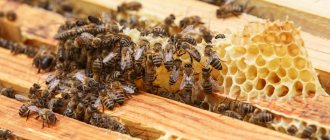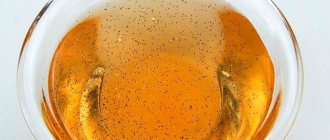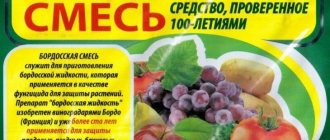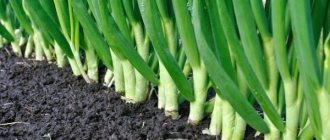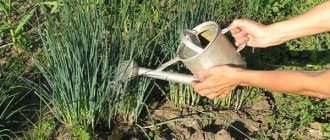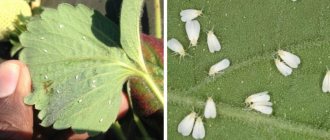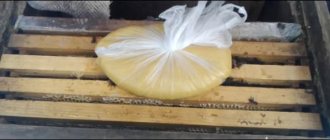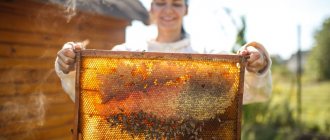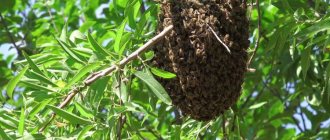With the arrival of spring, beekeepers have more troubles. After a long winter, insects need help to recover and gain strength for the start of the new season.
For this purpose, beekeepers feed the bees with sugar syrup in the spring in compliance with the required proportions.
Syrup for bees is not only a tasty food, but also a way to replenish food supply shortages. Because of hunger, the bees become restless. This has a bad effect on the quality of their work and the quantity of offspring.
Fertilizing eliminates these problems. The insects become saturated and prepare for active honey collection, and the queen lays more eggs.
Feeding bees: purpose, timing, methods and schemes
The vital activity and productivity of bees can sometimes decline. The cause may be natural factors, diseases, or insufficient nutrients. Additional nutrition of bees is carried out in order to increase the efficiency of the apiary.
- In autumn to replenish the loss of feed due to pumping out the natural product.
- In winter for adequate feeding of bee colonies.
- In spring to stimulate the uterus to lay eggs.
Sources of information used:
1. N. Bilash, B. Benevolenskaya. Bee food substitutes.
beejournal.ru/razvedenie-i-soderzhanie/2369-zameniteli-korma-pchel
2. Golub O.N. About autumn feeding. /Journal of Belarusian Pchalyar – 2012 No. 2 – P.34-36.
3. “Bees.” Russian beekeepers website.
4. “Inverted syrup.” Russian beekeepers website.
5. “Inverted syrup is the best way to feed bees,”
bolshemeda.ru/pchelovodstvo/invertirovannyj-sirop-dlya-pchel.html
6. “Using invert syrup for wintering. Six years of experience as a beekeeper from the Vinnytsia region of Ukraine,”
beepro.com.ua/topic/187
HE. Golub, Deputy Chairman of the Innovation Development Center “Novator”, Kirov.
Seasonal features and differences in fertilizing (autumn, winter and spring)
Increasing the immunity of insects and preventing their death depends on the timing of autumn feeding. Taking into account the different periods of onset of cold weather, which differ from year to year, it is necessary to calculate the timing of additional feeding so that the insects have time to process the food before the air temperature drops.
Did you know? A full-fledged bee colony consumes on average about 20 kg of protein and about 100 kg of carbohydrate feed per year.
At air temperatures below +10°C, bees produce less invertase. Bees synthesize the enzyme invertase, which is used to make honey from nectar. This enzyme is a catalyst for the breakdown of sucrose. The result is fructose and glucose. Thus, autumn fertilizing should be carried out in September.
A good wintering of little workers is provided with complete food and, if necessary, additional nutrition. Insects are stimulated by feeding before the start of the season in March-April.
Useful tips
To properly feed bees with sugar syrup in winter, several important nuances are taken into account:
- You should feed insects only with a high-quality product made from beet or cane sugar with good marketability. When using other products there is a risk of losing the bee colony.
- When adding salt and other components: fir oil, herbal infusions, it is important not to overdo it. Otherwise, the feeding will be untouched, and due to poor quality food, the bees will leave the hive.
- It is equally important to observe the timing of feeding the bees. If you provide food late, the insects will not have time to process it into honey and close the honeycombs before the cold season sets in.
- If you supply food ahead of schedule, only old insects that took part in the last honey collection will take part in its processing. The young offspring will not be involved in this process and will go to winter (in December or January) physically strong.
Preparing invert syrup with honey
Natural honey enzymes can be used to prepare an inverted concentrate.
The technological process is as follows:
- The water needs to be boiled.
- Add sugar.
- Stir until the sugar dissolves.
- Cool the solution to a temperature of +50°C.
- Add honey, the volume of which should be 5% of the total volume of the mixture.
- Pour the mixture into feeders.
Sugar syrup with citric acid
To speed up the metabolism of insects after the winter months, you can prepare a sweet solution with citric acid.
To do this you need:
- Dissolve 1 kg of sugar in 0.85 liters of hot water.
- Add 2 g of citric acid.
- Next, heat for 70 minutes in a water bath.
Important! The acidity of sugar syrup is neutral (pH 7.0). Honey is acidic (pH 3.7
–
4,1).
With the addition of industrial invertase
Industrial invertase is obtained from cultures of yeast and microscopic fungi. Invertase is a glycoprotein. The carbohydrate part of the molecule in yeast invertase is 30–80%, in mushrooms it is 10–12%.
Yeast and fungal invertase is active at pH 4.0–4.5 and temperature +45…+55°C. Hydrolysis of concentrated solutions of sucrose leads to the formation of monosaccharides, which are more soluble, do not crystallize, and are easily eaten by insects.
With added lactic acid
The inverted concentrate with the addition of lactic acid should be prepared in the following order:
- Take 1 kg of sugar.
- Take 0.5 liters of water.
- Add 2 g lactic acid.
- Dissolve sugar in water.
- Add lactic acid.
- Boil for 30 minutes.
Syrup using enzymes from lower organisms
When preparing a solution with yeast, use:
- Sweet liquid (proportion: 1 kg of sugar per 1 liter of water).
- Next, take 100 g of fresh baker's yeast and grind it with a small volume of solution.
- The yeast is then diluted with the resulting mixture.
- The solution should be brought to a boil.
We obtain a solution containing 5% yeast. It is poured into feeders. If you use dry yeast, then it must be dissolved in sweet water and kept warm for one day. Then combine with the concentrate.
Feeding rules
Feeding bees with sugar syrup for the winter is carried out in several ways:
- The most ideal option is to pour the solution into special feeders located above the bee colony’s nest.
- Liquid feeding in winter or spring is poured into a liter jar. The neck is wrapped in several layers of gauze. The container is turned upside down and fixed on the upper bars of the frame.
- Some beekeepers pour the syrup into plastic bags. They are filled with food, the air is released, tied tightly and placed on the upper bars of the frames. The bags are perforated in several places with a needle to provide the bees with access to food.
Feeding the bees
Preparation “Pchelit” for preparing invert syrup for bees
The drug "Pchelit" consists of enzymes from the yeast Saccharomyces cerevisiae Y2283, as well as vitamins and microelements. "Pchelit" is used in August or September. To prepare an inverted concentrate, you need to add the drug based on the proportion: 2 g of the drug per 5 kg of sugar. Autumn feeding with the drug - 8 g for each bee colony.
Proper planting and care of saponaria in a summer cottage
The root system contains a substance that forms foam upon contact with water. Has a cleansing effect. Therefore, our ancestors actively used saponaria for bathing and washing. Currently, the ingredients of this plant are used in cosmetics, medicines and some products. In addition, flowers fit perfectly into the landscape of the estate. Let's take a closer look at these unique flowers, and also learn how to grow soapwort in your garden.
Saponaria in all its glory
The underground part of the culture has a powerful rhizome with many branches. Thanks to its structure, saponaria creates lush “blankets” that decorate flower beds or lawns. Forms erect, creeping shoots. Their height sometimes reaches 80 cm. The stems can be bare or with many small bunches. All of them are decorated with leaves located on the opposite side.
Depending on the type, the leaves can be:
- congratulate linear-lanceolate; oval; broadly lanceolate.
In addition, the sepals have sharp or rounded edges. During flowering, the greenery thins into disc-shaped or paniculate inflorescences. The buds consist of five delicate petals in white, pink or purple. After successful pollination, the fruit appears. They are capsule-shaped with many black, oval-shaped seeds.
The beautiful medicinal soapwort (saponaria) belongs to the carnation family. In nature, it is found almost everywhere in Eurasia. Biologists have classified more than 40 varieties. However, only 10 of them are used in landscape design.
Medicinal
The perennial grows up to 80 cm. The buds are collected in disc-shaped inflorescences. Cultivated species include:
- Alba Plena; Betty Arnold; Rose of Plena.
Each of them has its own unique color. Moreover, some of them have the structure of a macerated bud.
Basilicofolia
Found in nature on the slopes of the majestic Alps. During flowering, it creates soft “carpets” up to 20 cm high.
Popular varieties:
- Camilla; Snow type; Splendes.
The buds are mostly pink in different shades. These varieties are very resistant to winter frosts. It reproduces by self-sowing, creating lush “thickets”.
Olivana
A recently discovered hybrid was obtained by combining dwarf and turf saponaria. Grows up to 5 cm. Creates dense and soft flower cushions.
Lamperjee
Its cultural form first appeared in southern Europe. The flower grows up to 40 cm. It has narrow, lanceolate, dark green leaves. Beautiful buds form at the tops of the stems.
Each of these types will decorate the garden landscape. The flower rug looks great on rocky alpine slides, in hanging boxes and along edges. The medical soap dish creates an original background for roses, peonies, lilies and decorative daisies.
Planting and caring for saponaria in an open flower bed
In the wild, the flower grows on rocky ground. Therefore, when planting medicinal saltwort, the type of soil is taken into account. The best option is limestone soil. It should contain a lot of drainage components, calcium and nitrogen, since the root system of the plant does not tolerate stagnant moisture.
Muddy soil should be mulched with fine crushed stone or gravel.
The place for planting saponaria and caring for it must meet three criteria:
- lots of sunshine; air space; ideal place for plants.
If you shade it, the color of the buds will lose its saturation. The petals will be pale, which will affect the decorativeness of the crop. Shading causes temperature fluctuations, which cause fungal infections. And tall “neighbors” can completely drown it out.
Having chosen a place for a flower bed, begin growing seponaria from seeds in open ground.
First, prepare the substrate by following these simple steps:
- weed rake; loosen the top layer of soil with a shovel or trowel; make shallow holes.
If a dense carpet is planned, the seeds are sown in random order. In addition, there is another way to grow soapwort in a personal plot. Let's look at how this is done with seedlings in mid-March.
Sowing is carried out in winter (October) or spring, when the soil has warmed up sufficiently.
Growing seedlings at home
In this case, you will need small pots or a large container. The containers are filled with a suitable substrate on top of the drainage layer. Wet the soil with a sprayer and then plant the seeds. Cover them with a thin layer of river sand and water gently again. Cover the container with glass or transparent foil. The seeds are placed in a warm room where the temperature is maintained at + 20 ° C. There should also be a lot of diffused light.
When the first shoots appear, the foil or glass should be removed immediately. Plants are regularly watered with water at room temperature and the top layer of soil is loosened. After the leaf blades develop, the seedlings are transplanted into separate pots.
14 days before planting in the ground, the seedlings are periodically taken outside to acclimate them to the outside temperature.
Planting in a flowerbed
Hardened seedlings are transferred to the flowerbed after the threat of spring frost has passed. In addition, the soil should be thoroughly warmed. In most regions of the country this period falls in mid-May.
The prepared area should be plowed and the ground leveled. Make holes in which the seedlings are placed at a distance of 30 cm from each other. Then the bed is watered with a sprayer.
When digging up the soil in the garden bed, it is advisable to arrange a drainage layer of sand and expanded clay.
Rules for feeding bees with invert syrup
Working women should be fed in the evening. In the fall, the prepared mixture is placed in feeders, and in the spring - in bags on frames. Depending on the desired result, you need to know the recommended proportions of sweet liquid.
Important! Bees tolerate winter better and develop better if they are fed with a solution of 60% concentration.
| Sugar syrup concentration, % | Water, l | Sugar, kg |
| 40 | 1,5 | 1,0 |
| 50 | 1,0 | 1,0 |
| 60 | 1,0 | 1,5 |
| 70 | 1,0 | 2,0 |
Liquid feed
Liquid food is more often used in the spring as a stimulator for the development of bee colonies. To prepare it, you need to bring 1 liter of water to a boil and add 1 kg of sugar to it with constant stirring. The concentrate yield in this case will be 1.6 liters, the sucrose concentration will be 50%.
Thick food
Thick food is often used in the fall. To prepare it, bring 1 liter of water to a boil and add 2 kg of sugar to it while stirring constantly. The result is a syrup with a concentration of 70% sucrose.
Dosage
It is important to know how many liters of liquid can be given at one time.
The dosage of inverted concentrate in the insect diet is as follows:
- For the first time, it is distributed in 0.5–1 liters per bee colony.
- Slow consumption of the product indicates that the portions are large. In this case, portions are reduced.
- Feeding dose: 3 liters per family for three days.
How to distribute
Pack the inverted concentrate into bags and place it on the honeycomb, then the insects will gnaw through the bag. You can place food on ceiling and frame feeders. The liquid should be warm. Do not allow the mixture to overheat above +50°C.
Did you know? An experienced
beekeeper leaves 25–30 kg of good-quality honey for bee colonies in the
fall
.
Why don't bees take syrup?
Sometimes insects do not take sweet liquid well. The reason for this may be illness or weakened condition of the bees. In this case, spraying the hive with a medicinal composition will help.
Another option for refusing syrup may be that the syrup concentration is too thick. In this case, it is necessary to reduce the dose of concentrate to prevent fermentation in the feeders.
Why feed in the spring?
Spring is an active period for bees, when it is necessary to build up strength for the upcoming honey harvest, which is usually held in July.
Spring feeding of insects is carried out for the following purposes:
- replenish food supplies;
- stimulate egg laying by the uterus;
- cure some diseases and prevent them using special supplements;
- improve the quality of honey, its aroma and taste;
- increase the overall productivity of the apiary.
Early spring is characterized by unstable weather, a lack of food in nature, a small amount of food in the nests and weakening of the bees.
If insects begin to fly out en masse for nectar, most of them will die. To prevent this, feed supplies are replenished.
Alternative methods of feeding bees
There are other mixtures that are used in beekeeping, in particular: candy, bee bread with milk, bee bread with the addition of yeast, sugar candies.
Kandi recipe
In apiaries, a product such as candy is used.
The recipe for its preparation is as follows:
- Honey - 1 serving.
- Powdered sugar - 4 servings.
- Heat honey in a water bath.
- Sift the powder through a sieve.
- Mix 2 components.
Kandy is used in winter.
Bee bread or its substitute
Bee bread is plant pollen that is collected by honeybees in the cells of honeycombs; it is a protein-carbohydrate food for insects. When using bee bread and its substitutes, take into account their effect on little workers. In spring, give beebread and milk. These products help raise brood. In autumn, feed bee bread and yeast. By consuming such a product, bees will be able to increase their protein supply, thus increasing their chances of surviving the winter. The source of protein is whole or powdered milk, as well as brewer's or baker's yeast.
To feed with whole milk, use thick sugar concentrate (70%) and an equal volume of milk. Give the finished mixture in small portions of 250 g in regular feeders. Powdered milk is mixed with honey, the resulting mass must be divided into 400 g frames.
Sugar candies
Sugar candies are also used as a top dressing.
To prepare them you need:
- Pour 1 part of water into the bowl.
- Add 5 parts sugar.
- Put on fire and boil for 30 minutes, stirring constantly.
- For 1 kg of sugar add 2 g of citric acid.
- The lollipops are ready when the mixture does not spread.
About inverting
Some beekeepers prepare invert syrup to feed bees. It is more easily processed by insects.
It is important to meet three conditions here:
- the amount of invert (most often citric acid);
- temperature regime;
- inversion time.
It is recommended to take 1.4 gamma citric acid per liter of liquid syrup or 2 grams of invert per kilogram of sugar. The temperature of the liquid when adding acid should be between 80-90 degrees Celsius. The inversion process lasts 70-90 minutes.
Sugar syrup is harmful to bees
The balance of benefit and harm from exposure to sucrose is obvious. If you feed bees sucrose, they are depleted of the production of protein enzymes, after which they cannot participate in raising the next generation. The brood is reduced by 30%, which causes their development to slow down. The lifespan of insects decreases. The uterus wears out and has to be replaced frequently. Do not overuse sugar supplements.
Insect diseases can be prevented by moderate honey collection, leaving food for the younger generation. It is necessary to preserve the population of bee colonies .
The beekeeper himself decides what food to give and what additives to use. The choice is very important not only for the effective management of his economy, but also for the entire population of the planet. Nowadays, preserving bee colonies is the primary task of every person. We wish you good honey harvest and healthy bee colonies!
Preparing bees for winter
Before wintering, the beekeeper has 5 main things to do with the hives that need to be done in the fall:
- prepare a place for wintering (winter house, omshanik, cellar, ditch);
- reduce the space inside (to make it easier to maintain heat - let the insects touch each other with their wings while sitting on adjacent honeycombs);
- insulate the outside (so that there are no gaps and the air does not blow out heat);
- protect from dampness (use breathable insulation);
- check whether there is enough food and whether the bees will need winter feeding.
If there is little honey stored (or left), then there is one more thing to do - prepare sugar syrup for additional winter feeding.
How to feed bees correctly
After preparing special food for bees, many beekeepers have an absolutely logical question - how to properly feed all this to the bees? There are no particular difficulties here, but there are several feeding options.
The easiest way is to place the syrup directly into the honeycomb. This process is carried out using a syringe or a teapot with a thin spout.
The second option is a plastic bag. Small holes are pierced in such a bag, approximately 1 liter of syrup is poured into it and placed in the hive. And then the bees will figure it out themselves.
Special feeders in the form of a box are also used; such a feeder is placed on top of the bee nest.
The side frame is also actively used for feeding with syrup. If the air temperature is low, then the frame is installed next to the socket, and if it is high, then it is placed behind the diaphragm.
If there are no specialized feeders in the apiary, then beekeepers can use ordinary glass jars. For such feeding, the jar is filled to the top with syrup and covered with gauze, previously folded four times. Next, you need to sharply turn the jar over and secure it to the nest frame. The bees will feed on the syrup, sucking it through the gauze and then storing it in the cells of the nest. For a strong bee colony, you can safely attach two or three jars at once.
A little advice for amateur beekeepers! Do not forget about the optimal temperature of the syrup. For better consumption by bees, the syrup must be placed in the hive warm, approximately 30-35 degrees Celsius, since cold syrup causes little interest among bees, and the frozen syrup will be much more difficult for striped workers to remove through a dense layer of gauze.
If the syrup is prepared well, bees will not have problems consuming it. They eat properly prepared syrup with great pleasure, which cannot be said about burnt syrup or one that has already been stored for a long time. Moreover, low-quality syrup is harmful to the health of bees. Also, do not forget that although syrup is a complete food for bees, it is still less useful than natural food or honey-based food. Therefore, it is better to avoid prolonged and monotonous feeding of bees only with sugar syrup; it is better to alternate it with honey, so the bees will be stronger, hardier and healthier, and will also be more likely to please young offspring.
If you do everything correctly and approach the issue of feeding bees seriously, then, thanks to feeding, you can be sure of a safe winter for striped bees during the cold season or when there is a lack of food. And in the spring, the bees will be more active and healthy, and will also begin to produce young offspring, which is undoubtedly an advantage.
Why is it necessary?
In the fall, only completely healthy bee colonies are fed. Insects spend a lot of effort and energy processing honey; the body wears out over time.
For this reason, insects from the brood are ready for wintering. Bees whose bodies have been weakened during honey processing may not survive the cold.
For health purposes, beekeepers mix families with each other - weak with strong and vice versa.
Feeding is necessary when:
- insufficient amounts of bribes and honey stored for the winter;
- pumping out honey to restore reserves;
- candiing a product set aside for the winter;
- absence of blockage of all cells without exception;
- the predominance of honeydew honey (produced from the sweet juice of insects and plants);
- adding medicines or other beneficial substances to honey.
Beekeepers' tricks
The most common problem that professionals encounter is using honey that is prepared with sugar added first. If this is ensured, then wintering will go much better, because the artificially created resource is worse and it is better to feed it first. To do this in the fall, during the feeding period, the hive is additionally equipped with frames, which must be made in advance and installed in the middle of the nest. Thanks to this action, most of the artificial honey will accumulate there, and when cold weather arrives, insects will begin to eat resources from the center of the nest, to its edges, and will primarily use up the sugar product.
The further question that should be dealt with is something like this: “How and when is autumn feeding done.” Basically, two methods of providing additional power are used:
- large batch (over 2 liters at a time);
- small dosage (1 l.).
The second method is considered the most productive, since insects process a small amount of resource faster and more efficiently. Autumn weather is colder than summer, and when the temperature changes, the amount of the invertase enzyme in the bees decreases. In addition to this, in hot weather the entire swarm works hard, and in the fall all the workers get tired and their productivity decreases several times.
Feeding a large volume of feeding at one time is used with a large colony in the hive and already formed offspring (new generation of female workers). It is advisable to feed with sugar syrup from a separate feeder; it is installed above the swarm house. This method is effective in autumn and spring; thanks to the convenient location above the hive, a person does not have to climb into it every time and, accordingly, disturb its inhabitants. But besides this method, sugar syrup can be poured into a pre-prepared plastic bottle with holes, filled with empty honeycombs, or using another option that the beekeeper comes up with. The feeding is placed in the feeder in a plastic bag, since drops of such a honey substitute should not be allowed to fall on the ground or on the hive. A portion of food should be given out in the evening so that the workers can fully absorb the resource received overnight. In addition to this, late time helps to avoid theft of a valuable product by strangers.
Types of feeders
Main types of feeders:
- The vertical feeder holds a large volume of liquid. If the temperature drops below 13°C, then the bees do not take food from such a container.
- A horizontal feeder is better in this regard. It is placed directly on the nest and is constantly warmed by the family. Bees take food from it almost all the time for themselves. The maximum container size reaches about 2-3 liters. To feed the bees for the winter, you have to repeatedly fill the feeder and constantly monitor the condition of it.
- The family is fed using ordinary plastic bags. Give the bee any amount of food (for example, 200 g or 8 l). The package is laid horizontally on the frame and is constantly heated by bees. Autumn feeding using bags is superior in its simplicity to any other method. Open the lid, lift the canvas and place the bag.
Bee feeder
Biotin - what kind of vitamin?
Biotin is known as vitamin B7 or vitamin H, in which case H stands for “Haar und Haut,” which is German for “hair and skin.” Biotin is soluble in water. The body does not store water-soluble vitamins, so people need to absorb it through food.
Biotin is required for the functioning of several enzymes known as carboxylases. Enzymes are part of important metabolic processes such as the production of glucose and fatty acids.
Recommended daily doses of biotin:
- 30 mcg for adults, including during pregnancy
- 35 mcg if breastfeeding
Biotin deficiency is quite rare. However, pregnant women and people who drink large amounts of alcohol may develop mild deficiency. Additionally, regularly eating raw eggs can cause biotin deficiency because eggs contain a protein called avidin, which binds to biotin, preventing it from being absorbed by the body.
Biotin - benefits for the body
Biotin plays a number of important roles in the body, including:
Macronutrient breakdown
Biotin helps the body convert food into energy by supporting a number of enzymes involved in the breakdown of carbohydrates, fats and proteins. In particular, biotin is involved in:
- Gluconeogenesis: This is the synthesis of glucose from sources other than carbohydrates such as amino acids, and biotin-containing enzymes help initiate this process.
- Fatty acid synthesis: Biotin helps enzymes that activate reactions important for fatty acid production.
- Amino acid breakdown: Biotin-containing enzymes are involved in the metabolism of several important amino acids, including leucine.
Nail Health Support
Biotin deficiency can lead to brittle nails. For people with deficiency, taking supplements containing biotin may improve nail strength. Changing your diet and other lifestyle factors can improve your nail health.
Biotin strengthens hair
Diet plays an important role in skin and hair health. For example, some foods for healthy hair include eggs, nuts, and oily fish. Does biotin help hair growth?
Many hair products contain biotin. Biotin deficiency can lead to hair loss, indicating that the vitamin is involved in maintaining healthy hair. However, little research has linked this vitamin to hair health in humans.
Biotin during pregnancy and breastfeeding
Biotin is very important for pregnant and breastfeeding women. While symptomatic manifestations of biotin deficiency are rare, low biotin levels are common during pregnancy. Moderate levels of deficiency can affect a person's health, but not enough to cause noticeable symptoms. Biotin deficiency is common among pregnant women because the body breaks down the vitamin faster during pregnancy. As a result, a pregnant woman may need more biotin.
Biotin for diabetes
Type 2 diabetes is a metabolic condition characterized by high blood sugar and impaired insulin function. Biotin deficiency can interfere with the regulation of blood sugar, or glucose, levels. Some evidence suggests that blood levels of biotin may be lower in people with diabetes. Animal studies have shown that supplements containing biotin and chromium picolinate may prevent insulin resistance.
Scientists also look at how biotin supplements affect blood sugar levels in people with type 2 diabetes. Results have been mixed, but some studies have shown that taking both biotin and chromium picolinate may help treat type 2 diabetes.
Biotin for skin
Scientists have not fully understood the role of biotin in maintaining skin health. However, people with biotin deficiency may have skin problems, including a red, scaly rash. It is believed that biotin can help with psoriasis. The effect of the vitamin on the skin may be related to its effect on fat metabolism. This process is important for maintaining healthy skin and may be impaired in people with low biotin levels
It's important to note that there is no evidence that biotin improves skin health in humans
Biotin for multiple sclerosis
Multiple sclerosis (MS) is an autoimmune disease that damages the protective covering of nerve fibers in the brain, spinal cord and eyes. This protective coating is called myelin, and biotin may play an important role in its production. Can biotin help with multiple sclerosis?
Research has shown that people with MS respond positively to daily doses of up to 300 milligrams of biotin. This supplement can stop the progression of the disease.
Recipes
You will need:
- 12 liters of water, 14 kg of sugar, 28 grams of citric acid - for spring feeding;
- 5 liters of water, 8 kg of sugar, 15 grams of acid - for preparing winter food.
Stages of making fudge:
- Boil the water. It shouldn't be tough.
- Pour it into a container with sugar. Use natural sugar without additives for this purpose.
- Stir the mixture until the sugar is completely dissolved.
- Cool the solution. As soon as the temperature drops to 45 degrees, you can add additives.
- Pack the food into plastic bags and place it on top of the hive.
